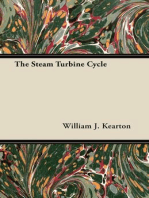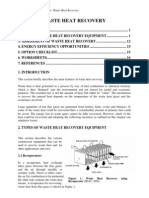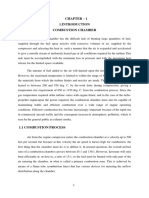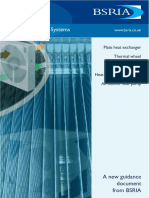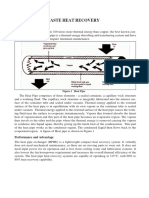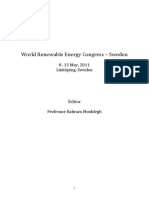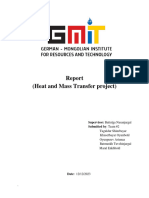4.15.5 Commercial Waste Heat Recovery Devices
4.15.5 Commercial Waste Heat Recovery Devices
Uploaded by
EngSafwanQadousCopyright:
Available Formats
4.15.5 Commercial Waste Heat Recovery Devices
4.15.5 Commercial Waste Heat Recovery Devices
Uploaded by
EngSafwanQadousOriginal Title
Copyright
Available Formats
Share this document
Did you find this document useful?
Is this content inappropriate?
Copyright:
Available Formats
4.15.5 Commercial Waste Heat Recovery Devices
4.15.5 Commercial Waste Heat Recovery Devices
Uploaded by
EngSafwanQadousCopyright:
Available Formats
8.
Waste Heat Recovery
8.5 Commercial Waste Heat Recovery Devices
Recuperators
In a recuperator, heat exchange
takes place between the flue gases
and the air through metallic or
ceramic walls. Duct or tubes carry
the air for combustion to be pre-
heated, the other side contains the
waste heat stream. A recuperator for
recovering waste heat from flue
gases is shown in Figure 8.1.
The simplest configuration for a
recuperator is the metallic radiation
recuperator, which consists of two
concentric lengths of metal tubing Figure 8.1 Waste Heat Recovery using Recuperator
as shown in Figure 8.2.
The inner tube carries the hot exhaust gases while the external annulus carries the
combustion air from the atmosphere to the air inlets of the furnace burners. The hot gases
are cooled by the incoming combustion air which now carries additional energy into the
combustion chamber. This is energy which does not have to be supplied by the fuel;
consequently, less fuel is burned for a given furnace loading. The saving in fuel also
means a
decrease in combustion air and therefore
stack losses are decreased not only by
lowering the stack gas temperatures but also
by discharging smaller quantities of exhaust
gas. The radiation recuperator gets its name
from the fact that a substantial portion of the
heat transfer from the hot gases to the surface
of the inner tube takes place by radiative heat
transfer. The cold air in the annuals,
however, is almost transparent to infrared
radiation so that only convection heat transfer
takes place to the incoming air. As shown in
the diagram, the two gas flows are usually
parallel, although the configuration would be
simpler and the heat transfer more efficient if
the flows were opposed in direction (or
counterflow). The reason for the use of
parallel flow is that recuperators
frequently serve the additional function
Figure 8.2 Metallic Radiation Recuperator of cooling the duct carrying away the
exhaust gases and consequently
extending its service life.
A second common configuration for
Bureau of Energy Efficiency 1
Figure 8.3 Convective Recuperator
8. Waste Heat Recovery
recuperators is called the tube type or convective recuperator. As seen in the figure 8.3,
the hot gases are carried through a number of parallel small diameter tubes, while the
incoming air to be heated enters a shell surrounding the tubes and passes over the hot
tubes one or more times in a direction normal to their axes.
If the tubes are baffled to allow the gas to pass over them twice, the heat exchanger is
termed a two-pass recuperator; if two baffles are used, a three-pass recuperator, etc.
Although baffling increases both the cost of the exchanger and the pressure drop in the
combustion air path, it increases the effectiveness of heat exchange. Shell and tube type
recuperators are generally more compact and have a higher effectiveness than radiation
recuperators, because of the larger heat transfer area made possible through the use of
multiple tubes and multiple passes of the gases.
Radiation/Convective Hybrid Recuperator:
For maximum effectiveness of heat transfer, combinations of radiation and convective
designs are used, with the high-temperature radiation recuperator being first followed by
convection type.
These are more expensive than simple metallic radiation recuperators, but are less bulky.
A Convective/radiative Hybrid recuperator is shown in Figure 8.4
Figure 8.4 Convective Radiative Recuperator
Ceramic Recuperator
The principal limitation on the heat recovery of metal recuperators is the reduced life of the
liner at inlet temperatures exceeding 1100oC. In order to overcome the temperature limitations of
metal recuperators, ceramic tube recuperators have been developed whose materials allow
operation on the gas side to 1550oC and on the preheated air side to 815oC on a more or less
practical basis. Early ceramic recuperators were built of tile and joined with furnace cement, and
thermal cycling caused cracking of joints and rapid deterioration of the tubes. Later
developments introduced various kinds of short silicon carbide tubes which can be joined by
flexible seals located in the air headers.
Bureau of Energy Efficiency 2
8. Waste Heat Recovery
Earlier designs had experienced leakage rates from 8 to 60 percent. The new designs are
reported to last two years with air preheat temperatures as high as 700oC, with much lower
leakage rates.
Regenerator
The Regeneration which is preferable
for large capacities has been very
widely used in glass and steel melting
furnaces. Important relations exist
between the size of the regenerator,
time between reversals, thickness of
brick, conductivity of brick and heat
storage ratio of the brick.
In a regenerator, the time between the
reversals is an important aspect. Long
periods would mean higher thermal
storage and hence higher cost. Also
long periods of reversal result in lower
average temperature of preheat and
consequently reduce fuel economy. Figure 8.5 Regenerator
(Refer Figure 8.5).
Accumulation of dust and slagging
on the surfaces reduce efficiency of the heat transfer as the furnace becomes old. Heat
losses from the walls of the regenerator and air in leaks during the gas period and out-
leaks during air period also reduces the heat transfer.
Heat Wheels
Figure 8.6 Heat Wheel
A heat wheel is finding increasing applications in low to medium temperature waste heat
recovery systems. Figure 8.6 is a sketch illustrating the application of a heat wheel.
Bureau of Energy Efficiency 3
8. Waste Heat Recovery
It is a sizable porous disk, fabricated with material having a fairly high heat capacity,
which rotates between two side-by-side ducts: one a cold gas duct, the other a hot gas
duct. The axis of the disk is located parallel to, and on the partition between, the two
ducts. As the disk slowly rotates, sensible heat (moisture that contains latent heat) is
transferred to the disk by the hot air and, as the disk rotates, from the disk to the cold air.
The overall efficiency of sensible heat transfer for this kind of regenerator can be as high
as 85 percent. Heat wheels have been built as large as 21 metres in diameter with air
capacities up to 1130 m3 / min.
A variation of the Heat Wheel is the rotary regenerator where the matrix is in a cylinder
rotating across the waste gas and air streams. The heat or energy recovery wheel is a
rotary gas heat regenerator, which can transfer heat from exhaust to incoming gases.
Its main area of application is where heat exchange between large masses of air having
small temperature differences is required. Heating and ventilation systems and recovery
of heat from dryer exhaust air are typical applications.
Case Example
A rotary heat regenerator was installed on a two colour printing press to recover some of
the heat, which had been previously dissipated to the atmosphere, and used for drying
stage of the process. The outlet exhaust temperature before heat recovery was often in
excess of 100oC. After heat recovery the temperature was 35oC. Percentage heat recovery
was 55% and payback on the investment was estimated to be about 18 months. Cross
contamination of the fresh air from the solvent in the exhaust gases was at a very
acceptable level.
Case Example
A ceramic firm installed a heat wheel on the preheating zone of a tunnel kiln where 7500
m3/hour of hot gas at 300oC was being rejected to the atmosphere. The result was that the
flue gas temperature was reduced to 150oC and the fresh air drawn from the top of the
kiln was preheated to 155oC. The burner previously used for providing the preheated air
was no longer required. The capital cost of the equipment was recovered in less than 12
months.
Heat Pipe
A heat pipe can transfer up to 100 times more thermal energy than copper, the best
known conductor. In other words, heat pipe is a thermal energy absorbing and
transferring system and have no moving parts and hence require minimum maintenance.
Bureau of Energy Efficiency 4
8. Waste Heat Recovery
Figure 8.7 Heat Pipe
The Heat Pipe comprises of three elements – a sealed container, a capillary wick structure
and a working fluid. The capillary wick structure is integrally fabricated into the interior
surface of the container tube and sealed under vacuum. Thermal energy applied to the
external surface of the heat pipe is in equilibrium with its own vapour as the container
tube is sealed under vacuum. Thermal energy applied to the external surface of the heat
pipe causes the working fluid near the surface to evaporate instantaneously. Vapour thus
formed absorbs the latent heat of vapourisation and this part of the heat pipe becomes an
evaporator region. The vapour then travels to the other end the pipe where the thermal
energy is removed causing the vapour to condense into liquid again, thereby giving up
the latent heat of the condensation. This part of the heat pipe works as the condenser
region. The condensed liquid then flows back to the evaporated region. A figure of Heat
pipe is shown in Figure 8.7
Performance and Advantage
The heat pipe exchanger (HPHE) is a lightweight compact heat recovery system. It
virtually does not need mechanical maintenance, as there are no moving parts to wear
out. It does not need input power for its operation and is free from cooling water and
lubrication systems. It also lowers the fan horsepower requirement and increases the
overall thermal efficiency of the system. The heat pipe heat recovery systems are capable
of operating at 315oC. with 60% to 80% heat recovery capability.
Typical Application
The heat pipes are used in following industrial applications:
a. Process to Space Heating: The heat pipe heat exchanger transfers the thermal energy
from process exhaust for building heating. The preheated air can be blended if
required. The requirement of additional heating equipment to deliver heated make up
air is drastically reduced or eliminated.
Bureau of Energy Efficiency 5
8. Waste Heat Recovery
b. Process to Process: The heat pipe heat exchangers recover waste thermal energy
from the process exhaust and transfer this energy to the incoming process air. The
incoming air thus become warm and can be used for the same process/other processes
and reduces process energy consumption.
c. HVAC Applications:
Cooling: Heat pipe heat exchangers precools the building make up air in summer
and thus reduces the total tons of refrigeration, apart from the operational saving of
the cooling system. Thermal energy is supply recovered from the cool exhaust and
transferred to the hot supply make up air.
Heating: The above process is reversed during winter to preheat the make up air.
The other applications in industries are:
• Preheating of boiler combustion air
• Recovery of Waste heat from furnaces
• Reheating of fresh air for hot air driers
• Recovery of waste heat from catalytic deodorizing equipment
• Reuse of Furnace waste heat as heat source for other oven
• Cooling of closed rooms with outside air
• Preheating of boiler feed water with waste heat recovery from flue gases in the heat
pipe economizers.
• Drying, curing and baking ovens
• Waste steam reclamation
• Brick kilns (secondary recovery)
• Reverberatory furnaces (secondary recovery)
• Heating, ventilating and air-conditioning systems
Case Example
Savings in Hospital Cooling Systems
Volume 140 m3/min Exhaust
Recovered heat 28225 kCal/hr
Plant capacity reduction 9.33 Tons of Refrigeration
Electricity cost (operation) Rs. 268/Million kCal (based on 0.8 kW/TR)
Plant capacity reduction cost (Capital) Rs.12,000/TR
Capital cost savings Rs. 1,12,000/-
Payback period 16570 hours
Economiser
In case of boiler system, economizer
can be provided to utilize the flue gas
heat for pre-heating the boiler feed
water. On the other hand, in an air
pre-heater, the waste heat is used to
heat combustion air. In both the cases,
there is a corresponding reduction in
Bureau of Energy Efficiency 6
Figure 8.8 Economiser
8. Waste Heat Recovery
the fuel requirements of the boiler. A economizer is shown in Figure 8.8.
For every 220 C reduction in flue gas temperature by passing through an economiser
or a pre-heater, there is 1% saving of fuel in the boiler. In other words, for every 60 C rise
in feed water temperature through an economiser, or 200C rise in combustion air
temperature through an air pre-heater, there is 1% saving of fuel in the boiler.
Shell and Tube Heat Exchanger:
When the medium containing waste heat is a liquid or a vapor which heats another liquid,
then the shell and tube heat exchanger must be used since both paths must be sealed to
contain the pressures of their respective fluids. The shell contains the tube bundle, and
usually internal baffles, to direct the fluid in the shell over the tubes in multiple passes.
The shell is inherently weaker than the tubes so that the higher-pressure fluid is circulated
in the tubes while the lower pressure fluid flows through the shell. When a vapor
contains the waste heat, it usually condenses, giving up its latent heat to the liquid being
heated. In this application, the vapor is almost invariably contained within the shell. If
the reverse is attempted, the condensation of vapors within small diameter parallel tubes
causes flow instabilities. Tube and shell heat exchangers are available in a wide range of
standard sizes with many combinations of materials for the tubes and shells. A shell and
tube heat exchanger is illustrated in Figure 8.9.
Figure 8.9 Shell & Tube Heat Exchanger
Typical applications of shell and tube heat exchangers include heating liquids with the
heat contained by condensates from refrigeration and air-conditioning systems;
condensate from process steam; coolants from furnace doors, grates, and pipe supports;
coolants from engines, air compressors, bearings, and lubricants; and the condensates
from distillation processes.
Plate heat exchanger
The cost of heat exchange surfaces
is a major cost factor when the
temperature differences are not
large. One way of meeting this
problem is the plate type heat
exchanger, which consists of a
series of separate parallel plates
forming thin flow pass. Each plate
is separated from the next by
gaskets and the hot stream passes
in parallel through alternative
Bureau of Energy Efficiency 7
Figure 8.10 Plate Heat Exchanger
8. Waste Heat Recovery
plates whilst the liquid to be heated passes in parallel between the hot plates. To improve
heat transfer the plates are corrugated.
Hot liquid passing through a bottom port in the head is permitted to pass upwards
between every second plate while cold liquid at the top of the head is permitted to pass
downwards between the odd plates. When the directions of hot & cold fluids are
opposite, the arrangement is described as counter current. A plate heat exchanger is
shown in Figure 8.10.
Typical industrial applications are:
u Pasteurisation section in milk packaging plant.
u Evaporation plants in food industry.
Run Around Coil Exchanger
It is quite similar in principle to the heat pipe exchanger. The heat from hot fluid is
transferred to the colder fluid via an intermediate fluid known as the Heat Transfer Fluid.
One coil of this closed loop is installed in the hot stream while the other is in the cold
stream. Circulation of this fluid is maintained by means of la circulating pump.
It is more useful when the hot land cold fluids are located far away from each other
and are not easily accessible.
Typical industrial applications are heat recovery from ventilation, air conditioning
and low temperature heat recovery.
Waste Heat Boilers
Waste heat boilers are ordinarily water tube boilers in which the hot exhaust gases from
gas turbines, incinerators, etc., pass over a number of parallel tubes containing water.
The water is vaporized in the tubes and collected in a steam drum from which it is drawn
off for use as heating or processing steam.
Because the exhaust gases are usually in the medium temperature range and in order to
conserve space, a more compact boiler can be produced if the water tubes are finned in
order to increase the effective heat transfer area on the gas side. The Figure 8.11 shows
a mud drum, a set of tubes over which the hot gases make a double pass, and a steam
drum which collects the steam generated above the water surface. The pressure at which
the steam is generated and the rate of steam production depends on the temperature of
waste heat. The pressure of a pure vapor in the presence of its liquid is a function of the
temperature of the liquid from which it is evaporated. The steam tables tabulate this
relationship between saturation pressure and temperature. If the waste heat in the exhaust
gases is insufficient for generating the required amount of process steam, auxiliary
burners which burn fuel in the waste heat boiler or an after-burner in the exhaust gases
flue are added. Waste heat boilers are built in capacities from 25 m3 almost 30,000 m3 /
min. of exhaust gas.
Bureau of Energy Efficiency 8
8. Waste Heat Recovery
Figure 8.11 Two-Pass Water Tube Waste Heat Recovery Boiler
Typical applications of waste heat boilers are to recover energy from the exhausts of gas
turbines, reciprocating engines, incinerators, and furnaces.
Case Example
Gases leaving a carbon black plant rich in carbon monoxide which are vented to the
atmosphere.
Equipment Suggested Carbon monoxide incinerator along with waste
heat boiler and steam turbine
Estimated equipment cost Rs.350 Lakhs
New boiler efficiency 80%
Savings by way of power generated ~Rs.160 Lakhs /annum
Indirect benefits Reduction in pollution levels
Heat Pumps:
In the various commercial options previously discussed, we find waste heat being
transferred from a hot fluid to a fluid at a lower temperature. Heat must flow
spontaneously “downhill”, that is from a system at high temperature to one at a lower
temperature. When energy is repeatedly transferred or transformed, it becomes less and
less available for use. Eventually that energy has such low intensity (resides in a medium
at such low temperature) that it is no longer available at all to perform a useful function.
Bureau of Energy Efficiency 9
8. Waste Heat Recovery
It has been taken as a general rule of thumb in industrial operations that fluids with
temperatures less than 120oC (or, better, 150oC to provide a safe margin), as limit for
waste heat recovery because of the risk of condensation of corrosive liquids. However,
as fuel costs continue to rise, even such waste heat can be used economically for space
heating and other low temperature applications. It is possible to reverse the direction of
spontaneous energy flow by the use of a thermodynamic system known as a heat pump.
The majority of heat pumps work on the principle of the vapour compression cycle. In
this cycle, the circulating substance is physically separated from the source (waste heat,
with a temperature of Tin) and user (heat to be used in the process, Tout) streams, and is
re-used in a cyclical fashion, therefore called 'closed cycle'. In the heat pump, the
following processes take place:
1. In the evaporator the heat is extracted from the heat source to boil the circulating
substance;
2. The circulating substance is compressed by the compressor, raising its pressure
and temperature; The low temperature vapor is compressed by a compressor,
which requires external work. The work done on the vapor raises its pressure and
temperature to a level where its energy becomes available for use
3. The heat is delivered to the condenser;
4. The pressure of the circulating substance (working fluid) is reduced back to the
evaporator condition in the throttling valve, where the cycle repeats.
The heat pump was developed as a space heating system where low temperature
energy from the ambient air, water, or earth is raised to heating system temperatures by
doing compression work with an electric motor-driven compressor. The arrangement of
a heat pump is shown in figure 8.12.
Figure 8.12 Heat pump
Bureau of Energy Efficiency 10
8. Waste Heat Recovery
The heat pumps have the ability to upgrade heat to a value more than twice that of the
energy consumed by the device. The potential for application of heat pump is growing
and number of industries have been benefited by recovering low grade waste heat by
upgrading it and using it in the main process stream.
Heat pump applications are most promising when both the heating and cooling
capabilities can be used in combination. One such example of this is a plastics factory
where chilled water from a heat is used to cool injection-moulding machines whilst the
heat output from the heat pump is used to provide factory or office heating. Other
examples of heat pump installation include product drying, maintaining dry atmosphere
for storage and drying compressed air.
Thermocompressor :
In many cases, very low pressure steam are reused as water after condensation for lack of
any better option of reuse. In many cases it becomes feasible to compress this low
pressure steam by very high pressure steam and reuse it as a medium pressure steam.
The major energy in steam, is in its latent heat value and thus thermocompressing would
give a large improvement in waste heat recovery.
The thermocompressor is a simple equipment with a nozzle where HP steam is
accelerated into a high velocity fluid. This entrains the LP steam by momentum transfer
and then recompresses in a divergent venturi. A figure of thermocompressor is shown in
Figure 8.13.
It is typically used in evaporators where the boiling steam is recompressed and used
as heating steam.
DISCHARGE
MOTIVE STEAM
STEAM M.P.
H.P.
SUCTION STEAM
LP
Case Example
Figure 8.13 Thermocompressor
Exhaust steam from evaporator in a fruit juice concentrator plant was condensed in a
precondenser operation on cooling water upstream of a steam jet vaccum ejector
Equipment Suggested Alt-1 Thermocompressor
Alt-2 shell &tube exchanger
Cost of thermocompressor Rs.1.5 Lakhs
Savings of jacket steam due to recompression of vapour Rs.5.0 Lakhs per annum
Cost of shell &tube exchanger to preheat boiler feed water Rs.75,000/-
Savings in fuel cost ~Rs.4.5 Lakhs per annum
Direct Contact Heat Exchanger :
Bureau of Energy Efficiency 11
8. Waste Heat Recovery
Low pressure steam may also be used to preheat the feed water or some other fluid where
miscibility is acceptable. This principle is used in Direct Contact Heat Exchanger and
finds wide use in a steam generating station. They essentially consists of a number of
trays mounted one over the other or packed beds. Steam is supplied below the packing
while the cold water is sprayed at the top. The steam is completely condensed in the
incoming water thereby heating it. A figure of direct contact heat exchanger is shown in
Figure 8.14. Typical application is in the deaerator of a steam generation station.
VENT
COLD WATER
IN
L.P. STEAM
HOT WATER
Figure 8.14 Direct Contact Condenser
Bureau of Energy Efficiency 12
8. Waste Heat Recovery
QUESTIONS
1. What do you understand by the term waste heat?
2. The heat recovery equipment will be the cheapest when the temperature of flue
gases are
(a) 2000C (b) 4000C (c) 6000C (a) 8000C
3. Give two examples of waste heat recovery.
4. What are the direct and indirect benefits of waste heat recovery?
5. How will you go about developing a waste heat recovery system?
6. Explain the various types of recuperators.
7. The ceramic recuperators can withstand temperatures upto
(a) 4000C (b) 17000C (c) 13000C (d) 14000C
8. Explain the operating principle of a regenerator.
9. What are heat wheels? Explain with sketch.
10. Explain the principle of operation of a heat pipe.
11. What are the typical applications of a heat pipe in heat exchangers ?
12. Explain the operation of an economizer.
13. How does a shell and tube heat exchanger work? Give typical examples.
14. How does a plate heat exchanger work? Give typical examples.
15. Explain the operating principle of a run around coil exchanger
16. Explain the operating principle of a waste heat recovery boiler with examples.
17. Explain the operating principle of a heat pump with examples
REFERENCES
1. Fuel Economy in furnaces and Waste heat recovery-PCRA
2. Heat Recovery Systems by D.A.Reay, E & F.N.Span, London, 1979.
www.bhes.com/frbbohome.htm
www.portalenergy.com
www.pcra.org
www.seav.vic.gov.au/ftp/advice/business/ info_sheets/HeatRecoveryInfo_0_a.pdf
Bureau of Energy Efficiency 13
You might also like
- Ochsner 2008 Carbon Dioxide Heat Pipe in ConjuncDocument6 pagesOchsner 2008 Carbon Dioxide Heat Pipe in ConjuncHugo PeresNo ratings yet
- Waste Heat RecoveryDocument11 pagesWaste Heat RecoveryKashifKhan100% (1)
- Regenerator & RecuperatorDocument33 pagesRegenerator & RecuperatorDhrubajyoti Das100% (1)
- MechVibration Lec1 PDFDocument45 pagesMechVibration Lec1 PDFEngSafwanQadous100% (1)
- Thermodynamic Study of Aircraft Air Conditioning Air Cycle Machine - 3-Wheel X 4-WheelDocument12 pagesThermodynamic Study of Aircraft Air Conditioning Air Cycle Machine - 3-Wheel X 4-WheelAlbertus DanartoNo ratings yet
- Assignment 1Document6 pagesAssignment 1kaushalshah28598No ratings yet
- Chapter-Waste Heat RecoveryDocument18 pagesChapter-Waste Heat Recoveryapi-19908130No ratings yet
- Waste HeatDocument6 pagesWaste HeatHassan MehrizNo ratings yet
- Assignment: Cogeneration and Waste Heat Recovery SystemsDocument8 pagesAssignment: Cogeneration and Waste Heat Recovery Systemsd_raj187No ratings yet
- Heat PipeDocument27 pagesHeat Pipesaurabh maneNo ratings yet
- Ijarme Vol1 Iss2 08Document8 pagesIjarme Vol1 Iss2 08avgpaulNo ratings yet
- Chapter 3Document29 pagesChapter 3dina safiriNo ratings yet
- Ceramic Heat Pipe For High Temperature Heat RecoveryDocument11 pagesCeramic Heat Pipe For High Temperature Heat RecoveryChander Prakash KamraNo ratings yet
- Optimization of Air Preheater Design ForDocument9 pagesOptimization of Air Preheater Design ForViktor TitahenaNo ratings yet
- Development of Two Adsorption Heat Pump / Air Conditioning Systems Dr. Robert E. Critoph, M.Inst.E University of Warwick, Coventry CV4 7AL, UKDocument6 pagesDevelopment of Two Adsorption Heat Pump / Air Conditioning Systems Dr. Robert E. Critoph, M.Inst.E University of Warwick, Coventry CV4 7AL, UKBalaji RajNo ratings yet
- Waste Heat RecoveryDocument4 pagesWaste Heat RecoveryMudasar JavedNo ratings yet
- Thermo Electric GenerationDocument6 pagesThermo Electric GenerationJournalNX - a Multidisciplinary Peer Reviewed JournalNo ratings yet
- Recuperator - Wikipedia, The Free EncyclopediaDocument3 pagesRecuperator - Wikipedia, The Free EncyclopediaAvijit DasNo ratings yet
- IJTRD16288Document3 pagesIJTRD16288Văn phòng Phân xưởng Vận hành 1No ratings yet
- Chap 20 PDFDocument18 pagesChap 20 PDFnelson escuderoNo ratings yet
- Combustion Chamber ProjectDocument42 pagesCombustion Chamber Project26 MaheshkannanNo ratings yet
- Aph 15Document0 pagesAph 15Parameswararao BillaNo ratings yet
- Heat PipeDocument12 pagesHeat PipemokaNo ratings yet
- Design and Characterizations of Solar Steam Engine Kim Jeff D. Beringuel July 2021Document19 pagesDesign and Characterizations of Solar Steam Engine Kim Jeff D. Beringuel July 2021Kim Jeff BeringuelNo ratings yet
- Heat Recovery Systems (Sample)Document3 pagesHeat Recovery Systems (Sample)Shoukat Ali ShaikhNo ratings yet
- PTQ Enhancing Heat TransferDocument5 pagesPTQ Enhancing Heat TransferkulaspiroNo ratings yet
- Performance Analysis of Separating and Throttling Calorimeter To Determine PDFDocument5 pagesPerformance Analysis of Separating and Throttling Calorimeter To Determine PDFCarolin megitaNo ratings yet
- Article 9Document10 pagesArticle 9Mamitina Rolando RandriamanarivoNo ratings yet
- Heat Recorery S3'stem.s: I. WarrenDocument15 pagesHeat Recorery S3'stem.s: I. WarrenPhilip ShihNo ratings yet
- Article-Tubos de Calor - Conceptos, Materiales y AplicacionesDocument9 pagesArticle-Tubos de Calor - Conceptos, Materiales y AplicacionesKathe PachónNo ratings yet
- 2012 - Thermodynamic Evaluation of Heat Recovery Through A Canopus Heat Exchanger For Vapor Compression Refrigeration (VCRDocument7 pages2012 - Thermodynamic Evaluation of Heat Recovery Through A Canopus Heat Exchanger For Vapor Compression Refrigeration (VCRBradley JohnsonNo ratings yet
- Heat Exchanger 4Document9 pagesHeat Exchanger 4Karter KhelaNo ratings yet
- Jornal Air Heater PerformanceDocument8 pagesJornal Air Heater PerformanceSu Crez No AtmajaNo ratings yet
- 1 2930051importDocument6 pages1 2930051importحيدرممتاز حسين نجمNo ratings yet
- Edited2 Enhancing Heat Transfer Efficiency and Performance of GravityDocument30 pagesEdited2 Enhancing Heat Transfer Efficiency and Performance of Gravitymansang.mc62No ratings yet
- Improve Vacuum Heater Reliability: Hydrocarbon ProcessingDocument4 pagesImprove Vacuum Heater Reliability: Hydrocarbon Processingros56No ratings yet
- 2203046876Document9 pages2203046876Ranjeet Kr SharmaNo ratings yet
- 10 26701-Ems 644733-1070465Document6 pages10 26701-Ems 644733-1070465Boubacar FofanaNo ratings yet
- Optimizing Chiller Tower Systems PDFDocument8 pagesOptimizing Chiller Tower Systems PDFasl91100% (1)
- Comb CycleDocument13 pagesComb Cyclerain55555No ratings yet
- Vera TutorialsDocument36 pagesVera TutorialsAbdulrazzaqAL-MalikyNo ratings yet
- Lect-5 FurnaceDocument60 pagesLect-5 FurnaceIffat0% (1)
- Heat SinkDocument21 pagesHeat SinkMuhammad Taufik Ali RahmanNo ratings yet
- Waste Heat Boiler Plate Heat ExchangersDocument8 pagesWaste Heat Boiler Plate Heat ExchangerskondusamyNo ratings yet
- ACTIVIDAD 1 Segundo Cohorte INGLES APLICADODocument4 pagesACTIVIDAD 1 Segundo Cohorte INGLES APLICADOsuleirith RamirezNo ratings yet
- Book To Study in ClassDocument25 pagesBook To Study in ClassMuhammadNo ratings yet
- 2013 - Fundamental Gas Turbine HeatDocument15 pages2013 - Fundamental Gas Turbine Heatfatimafatoum073No ratings yet
- 68-Solar Waste Heat Driven Two-Stage AdsorptionDocument9 pages68-Solar Waste Heat Driven Two-Stage Adsorptionali105No ratings yet
- c02 ExchangerDocument6 pagesc02 ExchangershaunsingerjesusNo ratings yet
- O 040894100Document7 pagesO 040894100IJERDNo ratings yet
- Economiser LiteratureDocument7 pagesEconomiser LiteratureSteve M D'souzaNo ratings yet
- Liu 2014Document5 pagesLiu 2014Ajinkya JagtapNo ratings yet
- Theoretical and Experimental Investigation of Heat Pipe Solar CollectorDocument8 pagesTheoretical and Experimental Investigation of Heat Pipe Solar CollectorKapil ChopraNo ratings yet
- ASU - Double Column ProcessDocument5 pagesASU - Double Column ProcessMH CNo ratings yet
- Solar Chimney Sizing and Design IntegrationDocument6 pagesSolar Chimney Sizing and Design IntegrationCalvin WongNo ratings yet
- WEAST HEAT RECOVERY Heating Purpose For Woldia University CaftiriaDocument10 pagesWEAST HEAT RECOVERY Heating Purpose For Woldia University CaftiriaMisge ChekoleNo ratings yet
- Heat Recovery SystemsDocument8 pagesHeat Recovery SystemsPranesh RajNo ratings yet
- Mechanics of the Household: A Course of Study Devoted to Domestic Machinery and Household Mechanical AppliancesFrom EverandMechanics of the Household: A Course of Study Devoted to Domestic Machinery and Household Mechanical AppliancesNo ratings yet
- Geothermal Energy: Sustainable Heating and Cooling Using the GroundFrom EverandGeothermal Energy: Sustainable Heating and Cooling Using the GroundNo ratings yet
- Thermodynamic analysis of geothermal heat pumps for civil air-conditioningFrom EverandThermodynamic analysis of geothermal heat pumps for civil air-conditioningRating: 5 out of 5 stars5/5 (2)
- D3PLOT Tips: Ls-Dyna EnvironmentDocument52 pagesD3PLOT Tips: Ls-Dyna EnvironmentEngSafwanQadousNo ratings yet
- Intro Artificial Intelligent PDFDocument71 pagesIntro Artificial Intelligent PDFEngSafwanQadousNo ratings yet
- PV Water Solar Energy 85 2433 PDFDocument10 pagesPV Water Solar Energy 85 2433 PDFEngSafwanQadousNo ratings yet
- A Long Heat PumpDocument7 pagesA Long Heat PumpEngSafwanQadousNo ratings yet
- Solar Energy Potential On The U.S. Outer Continental ShelfDocument14 pagesSolar Energy Potential On The U.S. Outer Continental ShelfEngSafwanQadousNo ratings yet
- Receiver Operator CharacteristicDocument5 pagesReceiver Operator CharacteristicEngSafwanQadousNo ratings yet
- Zaharah Binti Wahid: Academic QualificationDocument3 pagesZaharah Binti Wahid: Academic QualificationEngSafwanQadousNo ratings yet
- Excel ManualDocument37 pagesExcel ManualEngSafwanQadousNo ratings yet
- SM PW18 Phaam0812111c2Document55 pagesSM PW18 Phaam0812111c2EngSafwanQadousNo ratings yet
- Small18 PDFDocument35 pagesSmall18 PDFEngSafwanQadousNo ratings yet
- Name: - Address: - Telephone: - Mobile: - E-Mail Address: - EducationDocument1 pageName: - Address: - Telephone: - Mobile: - E-Mail Address: - EducationEngSafwanQadousNo ratings yet
- Leaf Spring PDFDocument7 pagesLeaf Spring PDFEngSafwanQadousNo ratings yet
- SMSV_Data_ManualDocument11 pagesSMSV_Data_ManualGerChuLu C.D.No ratings yet
- Daikin Ftke25bvm-Rke25bvm 1.0HPDocument169 pagesDaikin Ftke25bvm-Rke25bvm 1.0HPGrizono MassimoNo ratings yet
- Ecp 057 Vol 3Document393 pagesEcp 057 Vol 3mohammed gwailNo ratings yet
- Jj508 Lab SheetDocument57 pagesJj508 Lab Sheetadib1991No ratings yet
- Refrigeration and Air Conditioning Mechanic PDFDocument43 pagesRefrigeration and Air Conditioning Mechanic PDFGautham100% (2)
- Flow-Induced Fatigue Failure in Tubular Heat ExchangersDocument7 pagesFlow-Induced Fatigue Failure in Tubular Heat ExchangersVelpandian ManiNo ratings yet
- Mac 210 PDFDocument26 pagesMac 210 PDFJasser Sotela Bravo100% (2)
- Dynamic Analysisof Cross Flow Heat Exchangersin Data Centers Using Transient Effectiveness MethodDocument12 pagesDynamic Analysisof Cross Flow Heat Exchangersin Data Centers Using Transient Effectiveness MethodThejaswiniNo ratings yet
- DE04 Lesson 5 LContentDocument62 pagesDE04 Lesson 5 LContentVikas VikkiNo ratings yet
- Heat Exchanger Shell Id CalculationsDocument7 pagesHeat Exchanger Shell Id CalculationsmanojNo ratings yet
- Cost EstimationDocument85 pagesCost EstimationTowfiq Ahmed100% (1)
- SRL - Series Manual BookDocument62 pagesSRL - Series Manual BookPutra DwiantokoNo ratings yet
- Chilled Water DistibutionDocument56 pagesChilled Water DistibutionorganicspolybondNo ratings yet
- DONALDSON Buran DC 0020-1650 Refrigerate Dryer - Ver.29.06.2011 - enDocument6 pagesDONALDSON Buran DC 0020-1650 Refrigerate Dryer - Ver.29.06.2011 - enAriantoNo ratings yet
- 3361907Document17 pages3361907Chandresh Motka100% (1)
- Jenbacher: 1. Key To Module Diagrams and Technical Schema: - 1Document13 pagesJenbacher: 1. Key To Module Diagrams and Technical Schema: - 1Shimul sagorNo ratings yet
- BEE Best Practice Manual - HVAC ChillersDocument69 pagesBEE Best Practice Manual - HVAC ChillersHubert BonamisNo ratings yet
- Heat and Mass Transfer ProjectDocument17 pagesHeat and Mass Transfer ProjectoyunpurevoyunaaNo ratings yet
- Auxilio Calculo Keel CoolerDocument23 pagesAuxilio Calculo Keel CoolerGeorge Maximiano SilvestreNo ratings yet
- Inspection On EconomiserDocument2 pagesInspection On Economiserkrishna67% (3)
- Getting Start Hysys UnisimDocument38 pagesGetting Start Hysys UnisimBassem BalghouthiNo ratings yet
- TR 1 Air ConDocument6 pagesTR 1 Air ConLaarni De VeraNo ratings yet
- Sales Catalogue - Optimax Heat Pump - EnglishDocument8 pagesSales Catalogue - Optimax Heat Pump - EnglishYassine GharssalliNo ratings yet
- Areviewonopportunitiesforthedevelopmentofheatpumpdryingsystemsin South AfricaDocument12 pagesAreviewonopportunitiesforthedevelopmentofheatpumpdryingsystemsin South AfricaRackelyne UrbinoNo ratings yet
- Parametric Studies of An Automotive Air Conditioning SystemDocument4 pagesParametric Studies of An Automotive Air Conditioning SystemIDESNo ratings yet
- Penta Laser - ChillerDocument19 pagesPenta Laser - Chillermaintenancemachining03No ratings yet
- AOSCA80000Document62 pagesAOSCA80000arunNo ratings yet




